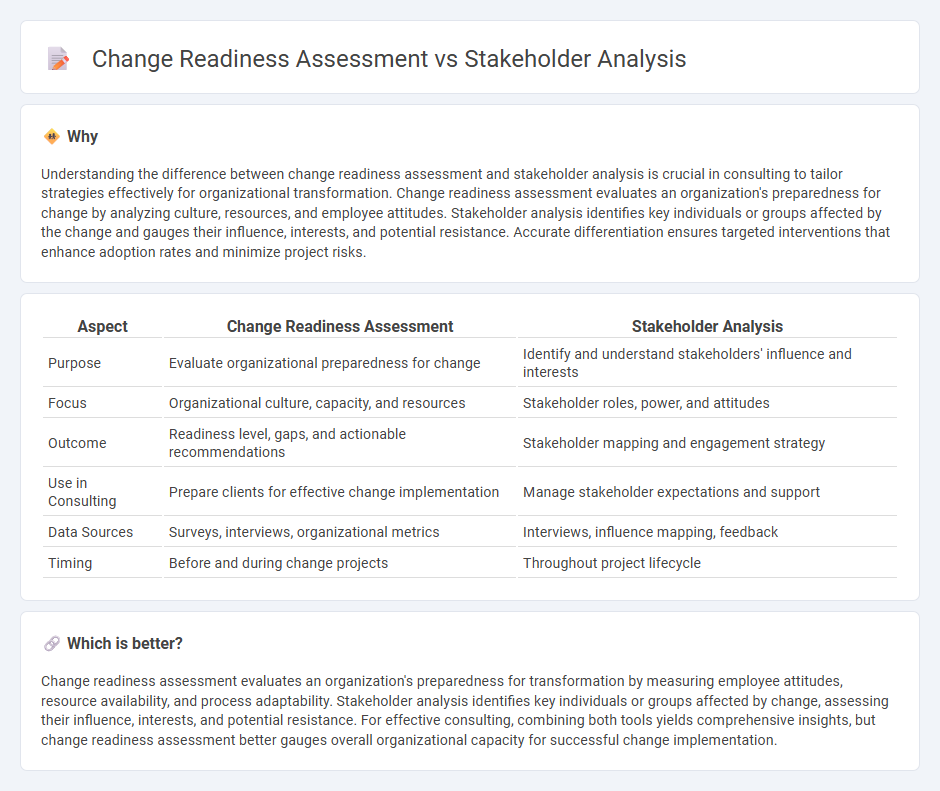
Change readiness assessment evaluates an organization's preparedness for upcoming transformations by measuring employee attitudes, resource availability, and leadership alignment. Stakeholder analysis identifies key individuals or groups affected by the change, assessing their influence, concerns, and engagement levels to tailor communication strategies effectively. Discover how integrating both approaches enhances successful change management initiatives.
Why it is important
Understanding the difference between change readiness assessment and stakeholder analysis is crucial in consulting to tailor strategies effectively for organizational transformation. Change readiness assessment evaluates an organization's preparedness for change by analyzing culture, resources, and employee attitudes. Stakeholder analysis identifies key individuals or groups affected by the change and gauges their influence, interests, and potential resistance. Accurate differentiation ensures targeted interventions that enhance adoption rates and minimize project risks.
Comparison Table
| Aspect | Change Readiness Assessment | Stakeholder Analysis |
|---|---|---|
| Purpose | Evaluate organizational preparedness for change | Identify and understand stakeholders' influence and interests |
| Focus | Organizational culture, capacity, and resources | Stakeholder roles, power, and attitudes |
| Outcome | Readiness level, gaps, and actionable recommendations | Stakeholder mapping and engagement strategy |
| Use in Consulting | Prepare clients for effective change implementation | Manage stakeholder expectations and support |
| Data Sources | Surveys, interviews, organizational metrics | Interviews, influence mapping, feedback |
| Timing | Before and during change projects | Throughout project lifecycle |
Which is better?
Change readiness assessment evaluates an organization's preparedness for transformation by measuring employee attitudes, resource availability, and process adaptability. Stakeholder analysis identifies key individuals or groups affected by change, assessing their influence, interests, and potential resistance. For effective consulting, combining both tools yields comprehensive insights, but change readiness assessment better gauges overall organizational capacity for successful change implementation.
Connection
Change readiness assessment evaluates an organization's preparedness for transformation by examining factors like employee mindset, resource availability, and process adaptability. Stakeholder analysis identifies key individuals or groups impacted by the change, their influence, and their support levels. Together, these tools provide a comprehensive picture of potential challenges and enable targeted strategies to align stakeholder engagement with organizational readiness, ensuring smoother change implementation.
Key Terms
**Stakeholder Analysis:**
Stakeholder analysis identifies and categorizes individuals or groups based on their influence, interest, and attitudes toward a project or change initiative, crucial for targeted communication and engagement strategies. It maps stakeholders' power, impact, and support levels to predict potential resistance and collaboration opportunities. Explore detailed methodologies and tools to enhance stakeholder analysis effectiveness.
Influence Mapping
Stakeholder analysis centers on identifying key individuals or groups based on their power and interest, crucial for Influence Mapping to prioritize engagement strategies effectively. Change readiness assessment evaluates the preparedness and willingness of these stakeholders to adopt change, providing insight into potential resistance or support levels. Explore how Influence Mapping integrates with these tools to optimize change management outcomes.
Interest Identification
Stakeholder analysis emphasizes mapping and categorizing individuals or groups based on their interests, influence, and attitudes toward a project, aiming to tailor engagement strategies effectively. Change readiness assessment evaluates stakeholders' preparedness, willingness, and capacity to adapt to organizational change, prioritizing areas requiring support and communication. Explore detailed methodologies and benefits of these approaches to optimize change management initiatives.
Source and External Links
Stakeholder Analysis: What Is and 3 Techniques To Approach - Stakeholder analysis systematically identifies, assesses, and understands stakeholders' perspectives to guide successful change, involving stakeholder mapping, categorization, and data collection for targeted strategies.
Stakeholder analysis - Wikipedia - Stakeholder analysis assesses stakeholders' interests and influence to balance demands in project plans or policies, categorizing stakeholders as primary, secondary, tertiary, and key based on their impact and importance.
How to Perform a Stakeholder Analysis | Lucidchart - This analysis involves identifying internal and external stakeholders, prioritizing them by influence and interest using a stakeholder grid, and determining communication strategies accordingly.
 dowidth.com
dowidth.com